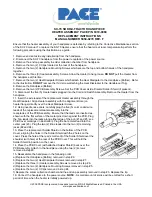
®
Set-up
PS-3204
3
013-14662B
or a Computer via Bluetooth
SPARKvue
Software Help
See the SPARKvue Help for information about collecting,
displaying, and analyzing data.
•
In SPARKvue, select the HELP button (
) in any
screen, including the Home Screen.
Connect the Sensor
•
In SPARKvue, select the Bluetooth icon. In
the
Wireless Devices
list that opens, select
the desired sensor that matches the
XXX-XXX Device ID number on the sensor.
Select Done.
Collect Data
•
In SPARKvue, select a measurement from the list
under the sensor in the Home Screen. A graph of the
measurement versus time opens.
•
Select the Start button to begin collecting data.
PASCO Capstone
Software Help
See the PASCO Capstone Help for information about
collecting, displaying, and analyzing data.
•
In PASCO
Capstone, select
PASCO Capstone Help
from the
Help
menu, or press
F1
.
Connect the Sensor
•
In PASCO
Capstone, click
Hardware Setup
in the
Tools
palette to confirm that the sensor is recognized.
Select the desired sensor in the
Hardware Setup
window that matches the XXX-XXX Device ID number
on the sensor. Close the
Hardware Setup
window.
Collect Data
•
In PASCO Capstone, select a display in the main
window. In the display, use the
<Select
Measurement>
menu(s) to set up the desired
measurement in the display.
•
Select
Record
to begin collecting data.
Collecting Data
1.
Rinse the end of the pH Probe with distilled water.
2.
Immerse the end of the pH Probe in the solution to be
measured. The bulb-shaped glass membrane should
be entirely immersed.
3.
Press or click start or record to begin recording data.
4.
Wait for the reading to stabilize.
5.
Rinse the end of the pH Probe again before placing it in
another solution.
Calibration
Calibration is not always necessary, especially if you are
measuring a change in pH rather than absolute pH values.
However, the pH Sensor can be calibrated. For detailed
theory of calibration, see Appendix B at the end of the
document.
Battery Usage
The Wireless pH Sensor includes a 3 V coin cell battery
(CR2032). Battery life is very important in making the
sensor simple and always ready to use, so all of the
PASCO wireless products are designed for long battery life.
For example, the sensor turns itself off after a short time of
inactivity.
We expect more than one year of battery life, but the actual
amount depends on factors such as the data collection
sampling rate.
Sensor Storage
If the sensor will be stored for many months, we
recommend that you remove the battery to avoid damaging
the sensor in case of a battery leak.
Battery Removal and Replacement
If the sensor’s battery status LED blinks red, the battery
may need to be replaced. Replacing the small, disk-shaped
battery involves removing the Battery Compartment Door
on the bottom of the sensor, removing the old battery,
installing a new battery of the same type, and replacing the
Battery Compartment Door. The procedure needs a coin
and a CR2032 three volt battery. (NOTE: This battery is
commonly available in electronic and commercial stores.)



























